3D customized total replacement and stem cell treatment
What part of the body is most frequently used in man’s every-day life?
Perhaps it comes in the order of neck, waist, shoulders and legs. Many people complain pain in the neck that comes from the fast-increasing use of smart phones. Then come the patients who complain pain in the neck that comes also from excessive use of smart phones.
Also on the fast increase are people suffering from obesity from lack of exercise who complain pain in the waist and knee joints. People who spend much time on computers also complain pain in the shoulders.
These working people are treated at the neurosurgery and orthopedic departments of the hospitals.
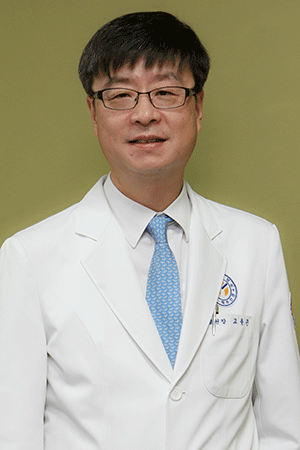
There are so many hospitals in Korea that treat patients suffering from joint and spine problems and naturally competition among them is very keen.
Among them is the Yonsei Sarang Hospital in Seoul. This hospital was established by the graduates of Yonsei University in Seoul, a most prestigious private university in Korea, and has been growing very fast in spite of the keen competition among hospitals. Yonsei Sarang specializes in the treatment of patients suffering from joint and spine problems. The Hospital is one of the largest in Korea that specialize in the treatment of patients suffering from joints and spine.
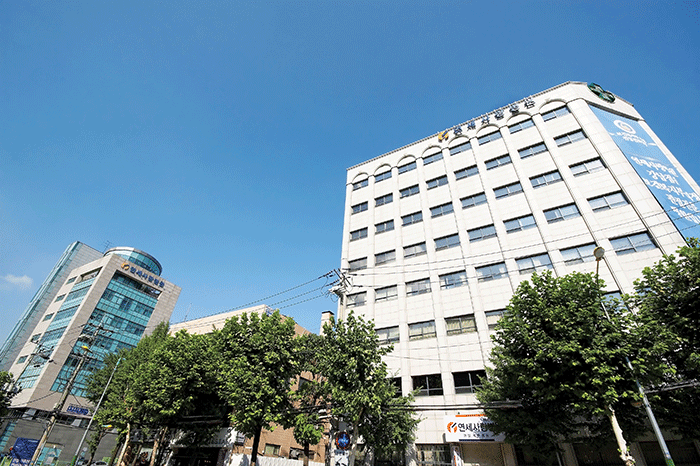 ▲Two main buildings of the Yonsei Sarang Hospital in Gangnam District in Seoul |
Established in 2003, the Hospital has a motto and slogan reading, “We provide the best treatment and give hopes to the patients!” Thus the Hospital tries to free the patients from the pains and worries of their spine and joint.
The Yonsei Sarang Hospital is well known not only among the Seoulites but also the people in the countryside. This is why a large number of patients visit the Hospital also from all parts of the country.
President Koh Yong-gon (M.D.) of the Hospital makes it a rule to visit the patients in the countryside once or twice each month, who have undergone treatment at his hospital, to see how they are faring after their treatment at his hospital as well as providing the local people with medical consultation.
The Hospital has doctors specializing in the many different fields such as knees, shoulders, feet, spine and various other parts of the human body and this is why the Hospital is so widely known among the patients for fast recovery from their problems.
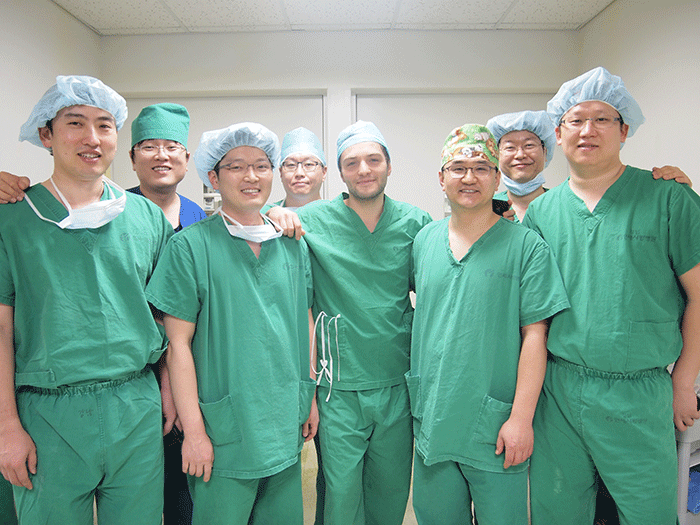 ▲Dr. Francesco Perdisa from Bologna University in Italy (fourth from right) poses with the doctors of the Yonsei Sarang Hospital at the time of his visit to the Hospital for a joint research on stem cell. |
The Yonsei Sarang Hospital is located in the Gangnam District south of the Han River in Seoul, and has a staff of a total of over 300 persons, including 20 doctors.
The Hospital makes substantial investments in R&D, which makes distinction from other hospitals covering spine and joints.
President Dr. Koh says: “We have developed a ‘3D customized total replacement system’ which has substantially improved the existing system--solving various problems in the existing system.” He said, “Furthermore, the Yonsei Sarang Hospital is known for the largest number of papers published overseas on the subject of ‘autologous adipose stem cell’ which is a system where cell is extracted from the patient’s buttocks, abdomen and thighs (where there is much fat) and injecting them into the knee joint.”
 ▲CEO Dr. Koh (right) poses with Dr. Allan Mishra from Stanford University during a joint research. |
“Thus,” says Dr. Koh, “We have successfully differentiated ourselves from other hospitals in terms of superiority of the doctors’ competence and skills.”
Furthermore, the Yonsei Sarang Hospital has an International Medical Treatment Team making itself an internationalized hospital and public relations efforts are being made for a wider dissemination of this information.
As a result of this development, an increasing number of patients are visiting from various countries of the world, including Russia, Kazakhstan, Mongolia, China and the United States. The Hospital is also preparing to establish in various countries of the world rehabilitation centers and cell treatment centers for the treatment of the local patients.
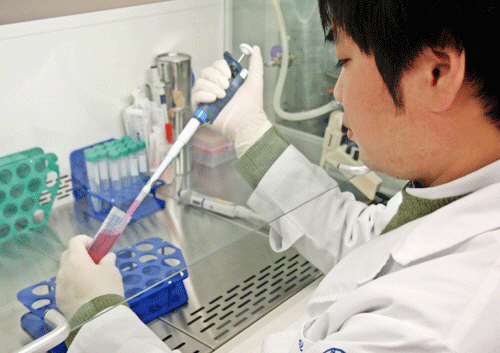
At present, the Hospital has coordinators who speak fluent foreign languages such as Russian and Mongolian as well as English, which greatly helps in eliminating languages barriers faced at the time of treating patients of different nationalities.
Also, doctors come to the Yonsei Hospital from various countries of the world, including Indonesia, Germany and Mongolia to learn the advanced medical skills from Yonsei. The Yonsei Sarang Hospital also concluded a medical cooperation agreement with various hospitals in Italy, Japan, China and Malaysia.
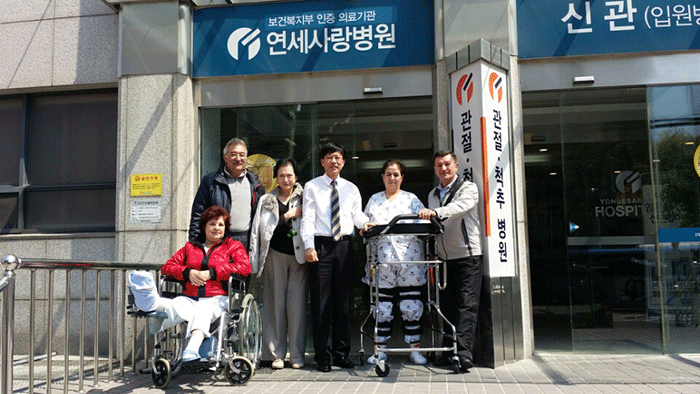 ▲Patients from Russia, Kazakhstan and Uzbekistan at the entrance of the Yonsei Sarang Hospital. |
The Yonsei Sarang Hospital plans to establish for the first time among the joint-spine hospitals in Korea a Stem Cell Institute to free the knee-joint patients from their pain and anxiety and to help them have new hopes. At this hospital, cell is extracted from the fatty part of the human body such as buttocks and abdomen and injected into the joints of the patients, especially the senior citizens, who suffer much pain due to aged and over-taxed cartilage. The injected cells cause regeneration of the cartilage. Extensive studies and researches are being conducted at the Hospital in that area.
At present, the new method is being used for the patients suffering from knee bone problems but the range of its use is expected to be expanded to the shoulders, spine and other parts of the human body.
Another epochal development of treatment method is through the use of ‘tailor-made’ 3D man-made joint, which was developed for the first time in Korea. The artificial joint enhances the accuracy of operation as it is done after completely checking the state of the patient.
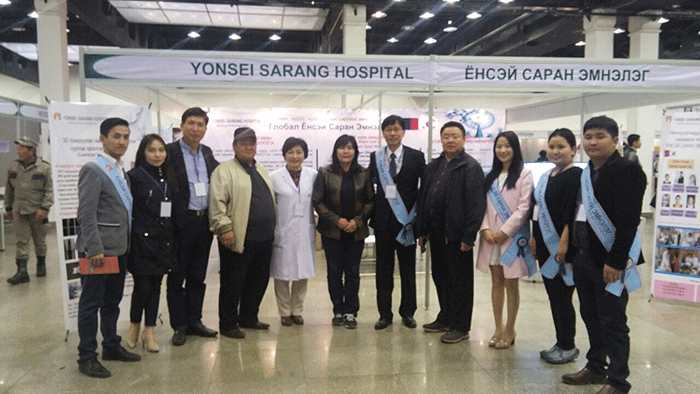 ▲Mongolian staff members at the Yonsei Sarang Hospital booth in the 2015 Mongolian International Health Fair . |
In contrast with the existing man-made joint where the ready-made joints are used, the newly developed 3D order-made joints are created through the use of a new method where the joint of the patient is ‘reconstructed’ based on MRI photography where the patient’s knee bone is reconstructed through 3D printing. This helps the creation of an artificial knee bone that is best fit to the patient.
The new method reduces the possible complication to the minimum compared with the existing method, and substantially reduces the operation time. The life span of the man-made joint, too, is more than 25 years compared with the 15 years of the existing ones. This is why the new artificial joints at the Yonsei Sarang Hospital are very popular among the knee patients.
Too, the Yonsei Sarang Hospital is equipped with special rehabilitation center facilities where the patients experience much shorter period of rehabilitation compared with other hospitals. This greatly helps the patients shorten the period of rehabilitation as well as the recovery period of the patents after operation. The patents greatly appreciate this and many of them have written letters of appreciation to the doctors who have treated them.
 ▲Rehabilitation Center at the Yonsei Sarang Hospital |
The Rehabilitation Center of the Yonsei Sarang Hospital is making preparations to enter Ulan Baatar, the capital city of Mongolia, in 2016 and this will be extended to Kazakhstan and Russia.
The Hospital has been selected by the Ministry of Health and Welfare as a Joint-specializing Hospital and a Globalized Hospital for Overseas Operations.
The Hospital has also won a Grand Prize in the field of joints for three consecutive years in the Medical Korea program organized by the Ministry of Health and Welfare from 2009 to 2011.
The Yonsei Sarang Hospital continues to make extended efforts to maintain the status of the most qualified hospital in the treatment of joints and spine.
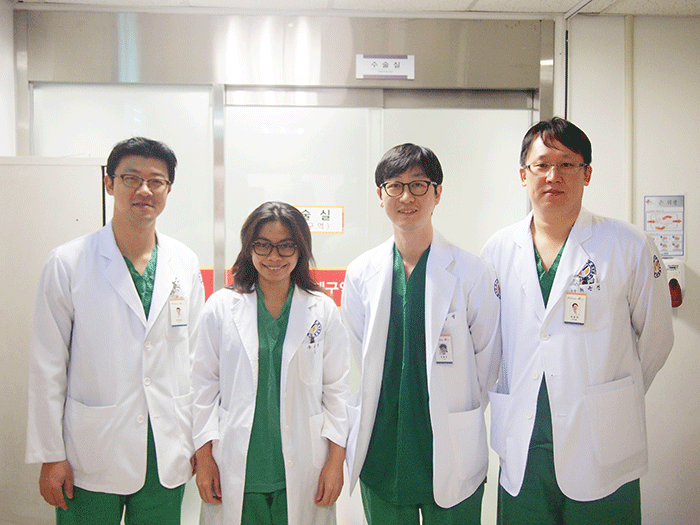 ▲A doctor from Siloamal Int'l Hospital in Indonesia visited the Yonsei Sarang Hospital to discuss the possibility of a joint research with the Yonsei Sarang Hospital. |

